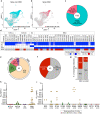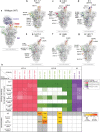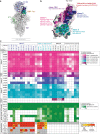Cross-Neutralization of Emerging SARS-CoV-2 Variants of Concern by Antibodies Targeting Distinct Epitopes on Spike
- PMID: 34781736
- PMCID: PMC8593667
- DOI: 10.1128/mBio.02975-21
Cross-Neutralization of Emerging SARS-CoV-2 Variants of Concern by Antibodies Targeting Distinct Epitopes on Spike
Abstract
Several severe acute respiratory syndrome coronavirus 2 (SARS-CoV-2) variants have arisen that exhibit increased viral transmissibility and partial evasion of immunity induced by natural infection and vaccination. To address the specific antibody targets that were affected by recent viral variants, we generated 43 monoclonal antibodies (mAbs) from 10 convalescent donors that bound three distinct domains of the SARS-CoV-2 spike. Viral variants harboring mutations at K417, E484, and N501 could escape most of the highly potent antibodies against the receptor binding domain (RBD). Despite this, we identified 12 neutralizing mAbs against three distinct regions of the spike protein that neutralize SARS-CoV-2 and variants of concern (VOCs), including B.1.1.7 (alpha), P.1 (gamma), and B.1.617.2 (delta). Notably, antibodies targeting distinct epitopes could neutralize discrete variants, suggesting that different variants may have evolved to disrupt the binding of particular neutralizing antibody classes. These results underscore that humans exposed to the first pandemic wave of prototype SARS-CoV-2 possess neutralizing antibodies against current variants and that it is critical to induce antibodies targeting multiple distinct epitopes of the spike that can neutralize emerging variants of concern. IMPORTANCE We describe the binding and neutralization properties of a new set of human monoclonal antibodies derived from memory B cells of 10 coronavirus disease 2019 (COVID-19) convalescent donors in the first pandemic wave of prototype SARS-CoV-2. There were 12 antibodies targeting distinct epitopes on spike, including two sites on the RBD and one on the N-terminal domain (NTD), that displayed cross-neutralization of VOCs, for which distinct antibody targets could neutralize discrete variants. This work underlines that natural infection by SARS-CoV-2 induces effective cross-neutralization against only some VOCs and supports the need for COVID-19 vaccination for robust induction of neutralizing antibodies targeting multiple epitopes of the spike protein to combat the current SARS-CoV-2 VOCs and any others that might emerge in the future.
Keywords: SARS-CoV-2; humoral immunity; immune memory; infectious disease; monoclonal antibodies; single cell; variants of concern.
Conflict of interest statement
Several mAbs generated from this work are being used by Now Diagnostics in Springdale, AR, for the development of a diagnostic test. The University of Chicago has filed a patent application relating to anti-SARS-CoV-2 antibodies generated in previous work (27), with P.C.W., H.L.D., and C.T.S. as coinventors. The Icahn School of Medicine at Mount Sinai has filed patent applications relating to SARS-CoV-2 serological assays and NDV-based SARS-CoV-2 vaccines, which list F.K. as a coinventor. F.A. is also listed on the serological assay patent application as a coinventor. Mount Sinai has spun out a company, Kantaro, to market serological tests for SARS-CoV-2. F.K. has consulted for Merck and Pfizer (before 2020) and is currently consulting for Pfizer, Seqirus, and Avimex. The Krammer laboratory is also collaborating with Pfizer on animal models of SARS-CoV-2.
Figures




Update of
-
Cross neutralization of emerging SARS-CoV-2 variants of concern by antibodies targeting distinct epitopes on spike.Res Sq [Preprint]. 2021 Jul 19:rs.3.rs-678247. doi: 10.21203/rs.3.rs-678247/v1. Res Sq. 2021. Update in: mBio. 2021 Dec 21;12(6):e0297521. doi: 10.1128/mBio.02975-21. PMID: 34312615 Free PMC article. Updated. Preprint.
Similar articles
-
Cross neutralization of emerging SARS-CoV-2 variants of concern by antibodies targeting distinct epitopes on spike.Res Sq [Preprint]. 2021 Jul 19:rs.3.rs-678247. doi: 10.21203/rs.3.rs-678247/v1. Res Sq. 2021. Update in: mBio. 2021 Dec 21;12(6):e0297521. doi: 10.1128/mBio.02975-21. PMID: 34312615 Free PMC article. Updated. Preprint.
-
Emergence of Multiple SARS-CoV-2 Antibody Escape Variants in an Immunocompromised Host Undergoing Convalescent Plasma Treatment.mSphere. 2021 Aug 25;6(4):e0048021. doi: 10.1128/mSphere.00480-21. Epub 2021 Aug 25. mSphere. 2021. PMID: 34431691 Free PMC article.
-
Neutralization potency of monoclonal antibodies recognizing dominant and subdominant epitopes on SARS-CoV-2 Spike is impacted by the B.1.1.7 variant.Immunity. 2021 Jun 8;54(6):1276-1289.e6. doi: 10.1016/j.immuni.2021.03.023. Epub 2021 Apr 1. Immunity. 2021. PMID: 33836142 Free PMC article.
-
Broadly-Neutralizing Antibodies Against Emerging SARS-CoV-2 Variants.Front Immunol. 2021 Sep 27;12:752003. doi: 10.3389/fimmu.2021.752003. eCollection 2021. Front Immunol. 2021. PMID: 34646276 Free PMC article. Review.
-
Analysis of the molecular mechanism of SARS-CoV-2 antibodies.Biochem Biophys Res Commun. 2021 Aug 20;566:45-52. doi: 10.1016/j.bbrc.2021.06.001. Epub 2021 Jun 5. Biochem Biophys Res Commun. 2021. PMID: 34116356 Free PMC article. Review.
Cited by
-
tANCHOR-cell-based assay for monitoring of SARS-CoV-2 neutralizing antibodies rapidly adaptive to various receptor-binding domains.iScience. 2024 Feb 5;27(3):109123. doi: 10.1016/j.isci.2024.109123. eCollection 2024 Mar 15. iScience. 2024. PMID: 38380248 Free PMC article.
-
Development of functionally relevant potency assays for monovalent and multivalent vaccines delivered by evolving technologies.NPJ Vaccines. 2022 May 5;7(1):50. doi: 10.1038/s41541-022-00470-4. NPJ Vaccines. 2022. PMID: 35513416 Free PMC article. Review.
-
Lack of memory recall in human CD4 T cells elicited by the first encounter with SARS-CoV-2.iScience. 2024 May 17;27(6):109992. doi: 10.1016/j.isci.2024.109992. eCollection 2024 Jun 21. iScience. 2024. PMID: 38868209 Free PMC article.
-
Age associated SARS-CoV-2 immune responses provide insights into population immunity over four years since the COVID-19 pandemic.Sci Rep. 2025 Jul 2;15(1):23183. doi: 10.1038/s41598-025-05737-z. Sci Rep. 2025. PMID: 40604011 Free PMC article.
-
Human-Immune-System (HIS) humanized mouse model (DRAGA: HLA-A2.HLA-DR4.Rag1KO.IL-2RγcKO.NOD) for COVID-19.Hum Vaccin Immunother. 2022 Nov 30;18(5):2048622. doi: 10.1080/21645515.2022.2048622. Epub 2022 Mar 29. Hum Vaccin Immunother. 2022. PMID: 35348437 Free PMC article.
References
-
- Baden LR, El Sahly HM, Essink B, Kotloff K, Frey S, Novak R, Diemert D, Spector SA, Rouphael N, Creech CB, McGettigan J, Khetan S, Segall N, Solis J, Brosz A, Fierro C, Schwartz H, Neuzil K, Corey L, Gilbert P, Janes H, Follmann D, Marovich M, Mascola J, Polakowski L, Ledgerwood J, Graham BS, Bennett H, Pajon R, Knightly C, Leav B, Deng W, Zhou H, Han S, Ivarsson M, Miller J, Zaks T. 2021. Efficacy and safety of the mRNA-1273 SARS-CoV-2 vaccine. N Engl J Med 384:403–416. doi:10.1056/NEJMoa2035389. - DOI - PMC - PubMed
-
- Garcia-Beltran WF, Lam EC, St Denis K, Nitido AD, Garcia ZH, Hauser BM, Feldman J, Pavlovic MN, Gregory DJ, Poznansky MC, Sigal A, Schmidt AG, Iafrate AJ, Naranbhai V, Balazs AB. 2021. Multiple SARS-CoV-2 variants escape neutralization by vaccine-induced humoral immunity. Cell 184:2372–2383.e9. doi:10.1016/j.cell.2021.03.013. - DOI - PMC - PubMed
-
- Wang Z, Schmidt F, Weisblum Y, Muecksch F, Barnes CO, Finkin S, Schaefer-Babajew D, Cipolla M, Gaebler C, Lieberman JA, Oliveira TY, Yang Z, Abernathy ME, Huey-Tubman KE, Hurley A, Turroja M, West KA, Gordon K, Millard KG, Ramos V, Da Silva J, Xu J, Colbert RA, Patel R, Dizon J, Unson-O’Brien C, Shimeliovich I, Gazumyan A, Caskey M, Bjorkman PJ, Casellas R, Hatziioannou T, Bieniasz PD, Nussenzweig MC. 2021. mRNA vaccine-elicited antibodies to SARS-CoV-2 and circulating variants. Nature 592:616–622. doi:10.1038/s41586-021-03324-6. - DOI - PMC - PubMed
-
- Wall EC, Wu M, Harvey R, Kelly G, Warchal S, Sawyer C, Daniels R, Hobson P, Hatipoglu E, Ngai Y, Hussain S, Nicod J, Goldstone R, Ambrose K, Hindmarsh S, Beale R, Riddell A, Gamblin S, Howell M, Kassiotis G, Libri V, Williams B, Swanton C, Gandhi S, Bauer DL. 2021. Neutralising antibody activity against SARS-CoV-2 VOCs B.1.617.2 and B.1.351 by BNT162b2 vaccination. Lancet 397:2331–2333. doi:10.1016/S0140-6736(21)01290-3. - DOI - PMC - PubMed
Publication types
MeSH terms
Substances
Supplementary concepts
Grants and funding
- #2020-215611/JPB Foundation
- HHSN272201400008C/AI/NIAID NIH HHS/United States
- U19 AI057266/AI/NIAID NIH HHS/United States
- HHSN272201600013C/AI/NIAID NIH HHS/United States
- T32 AI007090/AI/NIAID NIH HHS/United States
- HHSN272201400005C/AI/NIAID NIH HHS/United States
- JP19fk0108113/Japan Agency for Medical Research and Development (AMED)
- 75N93019C00051/AI/NIAID NIH HHS/United States
- U19 AI082724/AI/NIAID NIH HHS/United States
- U19 AI109946/AI/NIAID NIH HHS/United States
- U19AI082724/HHS | National Institutes of Health (NIH)
LinkOut - more resources
Full Text Sources
Other Literature Sources
Medical
Miscellaneous

